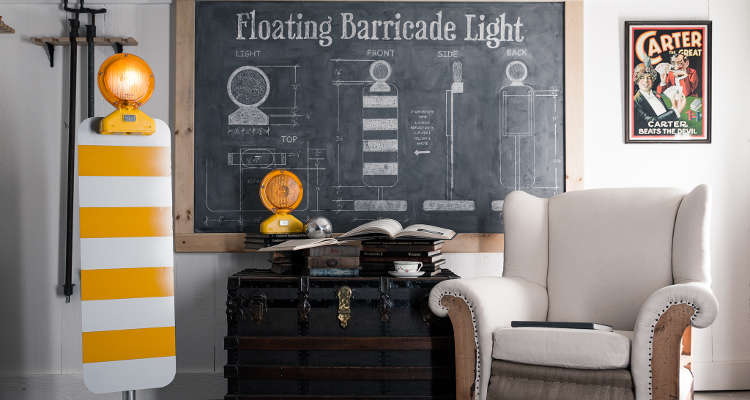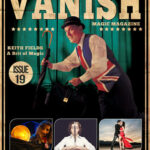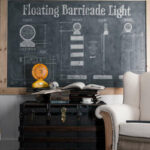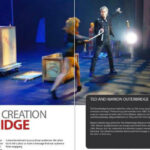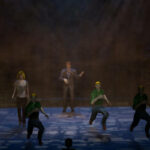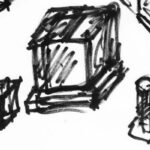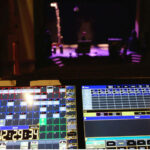Ted Outerbridge is a regular contributor to VANISH magazine and in his latest article he explores the creative process behind the development of new illusions for OUTERBRIDGE – Clockwork Mysteries. Despite the many hours Ted put into writing this article Marion managed to make the cover performing the Floating Barricade Light! VANISH has grown to an audience of over 100,000 in over 45 countries around the world. The magazine averages over 150 pages per issue and, best of all, all issues published in the current year are FREE. You can read OUTERBRIDGE – Concept to Creation, reprinted with permission from VANISH magazine, here:
VANISH, Edition 19, pages 80-84
OUTERBRIDGE – Concept to Creation
By Ted Outerbridge
When creating new material for our performances, the ultimate goal is to engage our audience and deliver a powerful experience of wonder that stays with them after the final curtain comes down. We strive to create something original, relevant and goosebump-inducing.
There are three basic criteria for adding a new piece to the show. It must fit in with the Time theme of our show, OUTERBRIDGE – Clockwork Mysteries. As well, it must be clearly different from what others are performing. We don’t add a piece merely because it is a great magic trick, however tempting this is. And finally, it must be relevant to us and our audiences. We often try to tell a story or share a message that our audience finds engaging.
Once we develop a preliminary concept for a new piece, it usually takes about three years until it is ready for the stage. After we start performing it, I find that it takes about three years until a piece really starts to gel. That is a total of six years to develop and refine a new piece. I don’t want to spend six years developing something that everyone else is doing, so originality is very important. Being original takes guts and it does not always work, but it is well worth the attempt, in my mind. I am not usually inventing new methods for illusions, but I always try to put my personal touch on what I do. When I watch a master magician they may or may not have a huge repertoire, but what they do, they do extremely well, and they do it in a way that is unique to them.
Working on a new piece requires brainstorming and inspiration, and Marion and I do a lot of both while driving about 20,000 miles (30,000 km) on our tours every year. When we return home we always have a pile of notes and sketches. They are in a variety of formats including on our phones, laptops and even on restaurant napkins. We record every reasonable idea along with a lot of insane ones. Our inspiration comes from books, magazines, music, museums, movies, architecture, personal belongings, our travels, experiences, and day-to-day life, or from a particular illusion we want incorporate into our show.
When we make the decision to move forward with a concept, we gather as much resource material as we can. This includes books, images, music, and videos of any performances by other magicians or other artists. Basically we look for all the published work on the topic. It is now time for the rest of our creative team to join in the excitement. In most cases this includes our illusion technician, creative consultant, set designer, costume designer, choreographer, lighting designer, sound designer, and my brother Peter who is a great devil’s advocate! We also include any specialists whose expertise will help the project. I strongly agree with the words of Henry Ford who said “I am not the smartest, but I surround myself with competent people.” Except I would say that our team are very competent people! The creative brainstorming continues until we are able to write a first draft of the script and draw some sketches of the set, costumes and props involved. These are often very primitive but they get us started!
When we are ready to create the props required, I draw up some preliminary plans on a large chalkboard in my workshop. If any commercially available plans are available that will help in the process, I purchase them. If any performance rights are necessary, I pay them. When a human (Marion or myself) is involved in an illusion, I usually build a mockup with cardboard or corrugated plastic sheets (Coroplast) and lots of gaffer tape to fine-tune the dimensions. By modifying the dimensions early on in the building process, I save a lot of time, money and stress-related illness! I highly recommend creating a full-size mockup before building an illusion.
Once the plans are ready, I locate suppliers and order the materials required. I also research any unusual construction options. For hardware options I look at www.leevalley.com and various marine suppliers who have high-quality brass and stainless steel hardware not found at any local hardware store. I always use the finest materials that are suitable, including hardwood and Baltic birch plywood (also called Russian birch). Baltic birch plywood is unique because every layer is birch veneer, so it is stronger and more stable than cabinet-grade plywood. Screws hold better, joints are cleaner, warping in minimized and it looks better. It costs a bit more than regular plywood but if one of my illusions falls apart onstage I am the one who will look like an idiot!
My workshop, aka “The Chamber of Curiosities”, is my Zen place where my body and mind come together and focus only on the prop or illusion I am building. I am a woodworker and I also love to work with aluminum, brass and other materials that add warmth and texture to my creations. I have been at it since I was 12 or so. When I am working on a new project I will vanish into the workshop for a week or more, and occasionally become so obsessed that I miss a night’s sleep.
The smallest details can become big issues when creating a new illusion. For example a simple piece of hardware that we took for granted may require an extensive search to locate the ultimate road-worthy piece. I know the prop will have a rough life bouncing around in trucks and airplanes, withstanding temperature extremes, and sometimes being treated brutally by local crews. It must function perfectly no matter what happens.
I don’t like to cut corners, so when I don’t have the ability to do something such as welding or powder-coating (applying very durable paint), I outsource it. My welder is always amused when I arrive with precisely-cut aluminium for a strange project like a seven-foot-tall alarm clock or a time machine! Having a good working relationship with my outsourced craftsmen is also important.
Every illusion I build travels in a road case, along with the tools required to assemble it and any backup hardware or accessories required. This way if a piece goes missing when we are on the road we have a replacement with us. For a new prop or illusion, I design the road case have it made. In Quebec, Canada, where I am located, I work with www.multi-caisses.com which provides well-made road cases at an affordable price with a quick turnaround.
Meanwhile Marion is designing and sewing costumes for the new routine, and she will involve a costume designer and/or a tailor depending on the complexity of the project. Our lighting designer Alex uses software called wysiwyg to create a photo-realistic rendering of his proposed designs. This step saves time and money as it is not necessary for us to rent a theatre in order to create the lighting design.
Rehearsals usually begin in our home and then move to a dance studio where we have more room. Marion is a world-class choreographer who also understands the complexities of an illusion show. She begins developing the choreography and then we usually involve a second choreographer as an outside eye, which is very helpful. We videotape our rehearsals and analyze them. We seek feedback from several people including the outside choreographer, our magic consultant, and a few other folks playing devil’s advocate. Our final rehearsals take place in a theatre. We never have enough time to rehearse but we make the most of the time we have. The new piece is constantly evolving and being fine-tuned as we rehearse, and this continues for as long as we are performing it.
The “Magic Alley” is an example of one of our creations. It began with the concept of two magicians jamming in an alley, and the tricks and illusions came later. Marion and I sought inspiration by hanging out in dark alleys looking for props and ideas – and in the process we met a lot of interesting people! We looked for objects you would find in an alley and we ended up with a cardboard box, a packing crate, a garbage can, a flashing barricade light, and a sleeping vagrant holding an empty bottle in a paper bag.
Here is what we were able to do with these components: To establish Marion’s character as a magician, she takes the empty bottle from the vagrant and vanishes it. Then she takes a rag from the garbage can and uses it to float a flashing barricade light. My years of turning Zombie gimmicks at Morrissey Magic helped with this project, as I had been on the lookout for something other than a Zombie ball to levitate. We will be releasing the Floating Barricade Light to the magic community in the very near future.
To complete the routine, I make my appearance out of an empty cardboard box (the Floating Box). Then I tie a rope around Marion and pull her through a small opening into a wooden packing crate (Jim Steinmeyer’s Through a One Inch Hole).
It is always exciting and nerve-wracking to perform a new piece for the first time. If it is working in our show, the audience will let us know. It will continue to evolve for as long as we perform it. On one occasion a spectator emailed me to let me know that she had been moved to tears by one of our illusions and, could she please have a copy of the script? I took this as the ultimate compliment. I will never stop striving to deliver a meaningful and powerful experience of wonder that endures long after the final curtain comes down.

